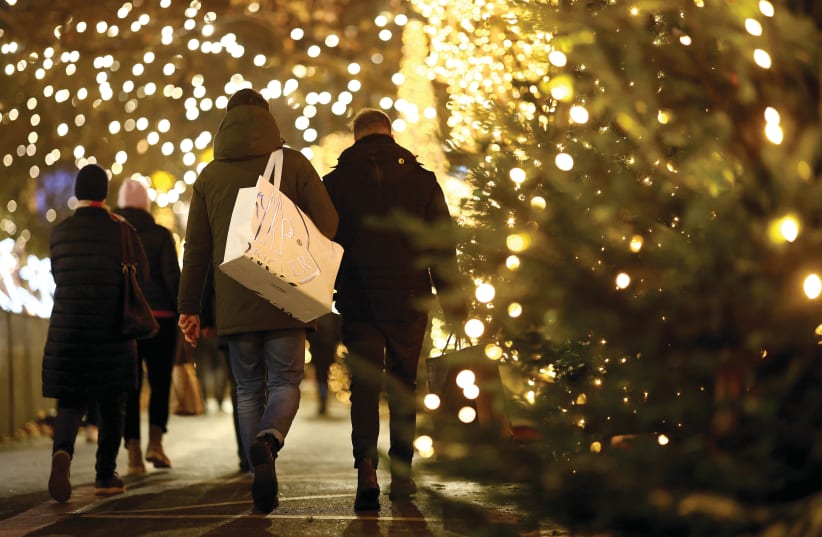In 1973, Jason Langer’s newly divorced mother, feeling a pull to her Jewish roots, took six-year-old Jason and his two brothers from their home in Tucson, Arizona, to live on Kibbutz Mishmar HaEmek. There they stayed until Jason was 11.
Each year on Yom Kippur, the kibbutz children were brought to the local Holocaust memorial, where they stood silently and listened to horrific stories of persecution and death wrought by the Nazis.
“We were asked to think about and deeply feel the pain, misery, and mass murder of our people; we were asked to set aside the fun times we were having in the children’s houses and consider how many people had lost their lives, so we could be somewhere safe. We were told we needn’t worry, but that we should be grateful to be living in Israel, our Promised Land. We were taken on the same field trip every year, and every year I feared it,” Langer laments.
The experience imbued Langer with a fear of Germany and Germans that lingered into adulthood, even as he settled in Oregon and built a career as an internationally exhibited and published photographer.
In 2008, Langer showed his urban night photographs at the Michael Hoppen Gallery in London. Hoppen then proposed that Langer photographed next in Berlin.
“Between 2009 and 2013, I confronted my fear and preconceptions and photographed Berlin with an eye towards places where Jews were hidden or deported.”
Jason Langer
With some trepidation, Langer accepted this suggestion. “Between 2009 and 2013, I confronted my fear and preconceptions and photographed Berlin with an eye towards places where Jews were hidden or deported,” he explained.
Langer explored the German capital mostly on foot, with two cameras loaded with black-and-white film.
“I decided to make a book which combines these pictures with images of today’s Berlin. The project shows the city’s dark past and brightness of today – a city of ghosts in continual renewal. It is a story of personal transformation, the making of new friends, remembrance of terror and acknowledgment that life continues.”
The resulting book is simply stunning. Langer describes his work aptly as “not a document; it is rather a dream within a dream within another dream.”
This unusual tome contains 135 duotone photographs and three essays – one by Langer, one by photography critic and curator Bill Kouwenhoven and one by Berlin journalist and editor Shelly Kupferberg, who was born in Israel.
Kupferberg notes that Langer’s “sharp eye reveals the broken, the evidence, the scarred, the clash of eras, and the earth-shattering.”
His magnificent black-and-white pictures convey an ominous feeling, no matter whether the subject is the Berlin Victory Column, the back of a policeman’s head or a trio of giraffes in the Berlin Zoo.
THERE ARE plenty of inherently chilling images, such as a garage door of former Gestapo headquarters, Stasi Prison where 20,000 political prisoners were held by East Germany, and the pathology table at Sachsenhausen.
There are symbolism-laden scenes such as Menashe Kadishman’s installation “Shalekhet (Fallen Leaves)” comprising more than 10,000 round iron plates fashioned into faces with open mouths; and mundane scenes such as a woman sitting on a bed and a man with a black dog.
“I am deeply grateful for the privilege to commingle the history of different eras with fantasy, pain, and everyday life,” Langer states.
The photos are organized not by category, but geographically from west to east. Langer calls this orientation “a metaphorical walk in the direction of the rising sun and into my own past.” The effect speaks visual volumes about the author’s conflicted emotions.
“This book is an attempt to remember, confront, and unwind my attitudes about Germans, Germany, Berlin, and my Jewish inheritance; these images are part discovery, part remembrance, and part fantasy. They’re my attempt to stand where Jewish people were rounded up and deported, to remember but also reassess. They’re an effort to confront my internal attitudes and prejudices, to look into Berliners’ eyes and find a continuation of kindness, to be open to the happiness of contemporary life in Berlin,” Langer says.
Today, Langer teaches others how to use photography as an avenue to personal discovery. His photographic trips to Berlin surely serve as his guide in this endeavor.
I was left breathless by Langer’s images, and I learned much from the essays. Kouwenhoven, for example, explains that Berlin’s name comes from the old Slavic word birl, swamp. “[A]s one crunches one’s way across the sandy, stony streets, one notices at first glance that the city is truly a complex of castles built on sand.”
I disliked only one aspect of Berlin: most of the photograph captions are grouped at the end instead of appearing alongside the images. I hope that in future editions this design flaw will be corrected to facilitate a more reader-friendly experience.
Released in November, Berlin will be presented at international book and art fairs in Frankfurt, London, Los Angeles, New York, Paris, Beijing, Vienna and other cities.
BerlinBy Jason LangerKerber Verlag Publishers180 pages, $65

